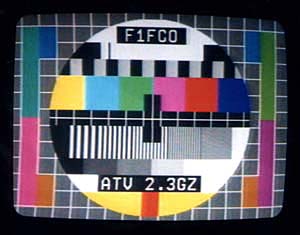
ATV on 2300 MHz
Reception
The television set
The standard in amateur television on 2320 MHz is the standard used in satellite broadcasting, except for large DX where the excursion is reduced.
Thus the receiver will be a commercial receiver, preferably Bi-standard PAL-SECAM (in
Europe) but amateurs use more and more PAL standard.
It is necessary to avoid the too sophisticated TV sets which pass on a blue screen when the signal weakens, they make very difficult the search of weak signals.
The satellite receiver (tuner)
Any satellite receiver covers at least 950 MHz to 1750 and now 2050 MHz; the idea is to put a specific 2300 MHz converter in front of this satellite tuner.
There were descriptions of 2300 converters designed in this spirit; another very simple solution and which functions extremely well consists in finding a " ARABSAT " head satellite ; these heads cover from 2500 to 2700 MHz and function largely on 2300.
The ARABSAT head (or the specific converter) is supplied by the coaxial cable. It must be placed the more close possible to the antenna.
The ARABSAT solution was adopted on our repeaters F1ZGM and F5ZGN (Aigoual mount), but on sites where are cohabiting many transmitters, an interdigital filter (*) is necessary in front of the 2300 head because its too broad input bandwidth.
Emission
The standard is frequency modulation, with one or even several sub carriers; at least one for the sound, the whole area from Marseille to Narbonne was standardized with sub carrier sound at 6,5 MHz; 16 dB below the picture carrier.
The levels are the same ones as on1255: when one puts 1Vcc video to the input of the transmitter, the correspondent must obtain exactly 1Vcc video at the output of his tuner.
For the sound, when one puts .5 Vcc audio to the input of the transmitter, the correspondent must obtain exactly .5Vcc audio at the output of his tuner.
There were many descriptions of transmitters these last years, in general, the 2320 is produced by a VCO followed by a 256 divider.
The VCO is frequency modulated by the vidéo+soud sub carrier,sound carrier itself modulated in FM; the signal is post amplified by MMIC and attacks a final transistor.
Video qualities are impressive, the limitation in quality with these transmissions is at the sources (camera, video tape recorders) and at the screens of the television sets, but not in the transmitting and receiving chain.
Antenna
In television, the least decibel counts, one can receive television locally with quad elements (*) in front of a reflector, it's what we use at the Aigoual mount with F5ZGN, but it is 1650 m high.
The maximum must be done at the antenna if we want better results: 25 elements ATV Yagi is a first solution, but sensitive to the rain, a loopYagi (*) is interressant too; it is good on these frequencies to start thinking parabola, 60 cm or more, fed by a double quad in front of a plane reflector.
Don't be too full of hope however, in television it is better to live on a hill, the contact will be made only if there is no obstacles between the correspondents (except reflexion), and on these frequencies, foliage of tree starts to be an obstacle.
(*) in French
Return to the welcome page
© 1999-2011 A. Ducros F5AD